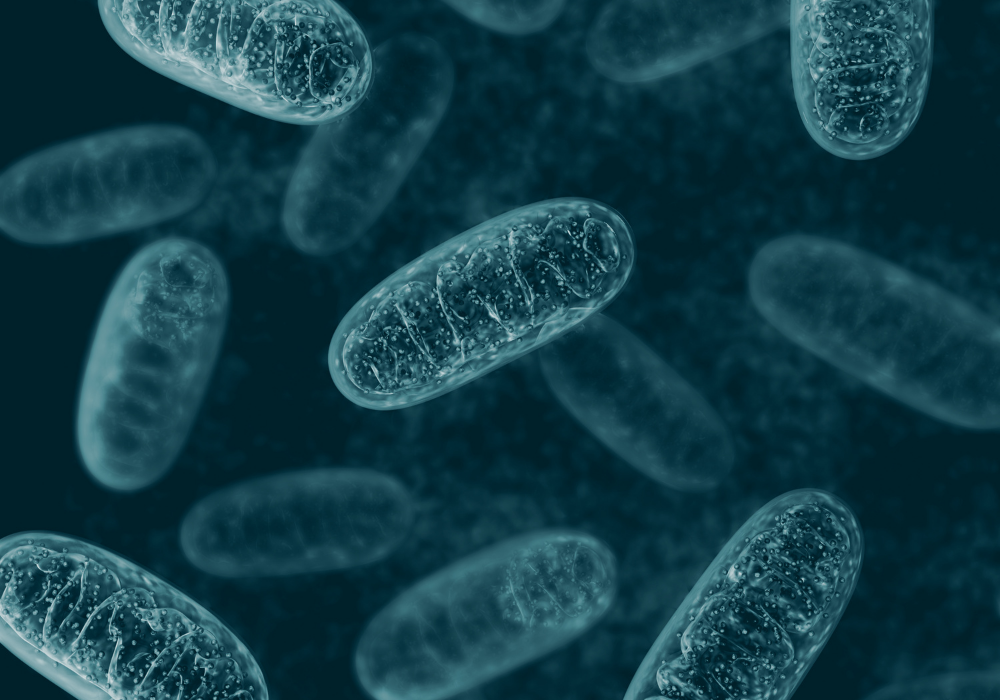And why it matters for your energy levels
In the field of cellular longevity, few things are as fundamental yet misunderstood as the mighty mitochondria. These tiny organelles are often referred to as the "powerhouses" of the cell, and for good reason. They are central to metabolism, particularly through their role in ATP energy production, which impacts almost every major cellular structure and function from skin health, to brain health, energy levels and ageing of our organs and systems. Therefore, appreciating the role of mitochondria in metabolism is crucial to understanding how energy is made, why we lose it over time, and how we might optimise and restore it.

What is the Mitochondria’s Role in Metabolism?
Mitochondria are membrane-bound organelles found in every cell of the body, except red blood cells. Their primary function is to produce adenosine triphosphate (ATP), the body’s cellular energy currency. They do this through a process known as oxidative phosphorylation, which occurs in the electron transport chain within the mitochondrial inner membrane.
When we talk about mitochondria and metabolism, we are referring to how mitochondria convert nutrients from food, like glucose and fatty acids, into usable energy via intricate biochemical reactions known as metabolic pathways in mitochondria. These include glycolysis (outside the mitochondria), the Citric Acid/Krebs cycle, and the Electron Transport Chain (within the mitochondria).
What is ATP in Biology and How Is It Produced?
ATP is the energy molecule that fuels virtually all biological processes from muscle contraction to cellular repair.
ATP is produced in several steps:
- Nutrients from carbohydrates, protein and fats are broken down into smaller molecules.
- These molecules enter the Krebs cycle (also known as the citric acid cycle).
- The cycle produces electrons that are fed into the electron transport chain.
- Oxygen acts as the final electron acceptor, allowing for the production of large amounts of ATP in the mitochondria.
When mitochondrial function declines, so too does our capacity to produce ATP, which ultimately affects our energy levels holistically.
Why Is Mitochondrial Function Important for Energy and Health?
Efficient mitochondrial function ensures that cells receive enough energy to perform their roles. This is particularly vital for high-demand organs such as the brain, muscles, skin, and heart. Mitochondrial dysfunction has been implicated in a wide range of conditions, including:
- Chronic fatigue
- Cognitive decline
- Metabolic syndrome
- Premature signs of ageing
- Skin dullness and inflammation
As we age, mitochondrial efficiency decreases and the number of functioning mitochondria may decline, leading to systemic effects. According to Verdin (2015), this is partly due to declining levels of NAD+, a key coenzyme required for mitochondrial function. This is why NAD+ boosting is so important in addressing lifestyle and age-related decline.

What Causes Poor Mitochondrial Function?
Several factors can compromise mitochondrial efficiency:
- Ageing: Natural decline in NAD+, antioxidant defences, and mitochondrial biogenesis
- Inflammation: Oxidative stress damages mitochondrial membranes and DNA
- Nutrient Deficiencies: Low levels of magnesium, CoQ10, and B vitamins
- Toxin Exposure: Environmental pollutants, alcohol, and smoking
- Sedentary Lifestyle: Reduces mitochondrial density and adaptability
Zong et al. (2024) outline how mitochondrial damage plays a critical role in degenerative diseases and ageing by disrupting energy production and increasing oxidative stress.
How Can I Support Healthy Mitochondrial Metabolism?
Fortunately, mitochondrial health can be improved. Here are some evidence-backed strategies to improve mitochondrial function:
- Exercise: Particularly high-intensity and resistance training stimulate mitochondrial biogenesis
- Nutrient-Dense Diet: Include sources of antioxidants, B vitamins, magnesium, plant diversity, healthy fats and minimally processed foods.
- Intermittent Fasting/Time Restricted Feeding: May enhance mitochondrial health.
- NAD+ Precursors: Such as nicotinamide riboside (NR) and niacinamide (NAM) to replenish declining NAD+ stores
- Targeted Supplements: Including mitochondrial antioxidants like CoQ10, PQQ, quercetin and resveratrol
Zhang et al. (2022) highlight the role of mitochondrial support in delaying cellular senescence and promoting longevity.
Supplements That Support ATP Production and Mitochondrial Health
The science behind mitochondrial health is what inspired SynTernals to create NRgize+. Formulated with NAD+ precursors (nicotinamide riboside), resveratrol, and quercetin, NRgize+ is designed to target energy production at the cellular level.
NRgize+ helps support:
- ATP energy production
- Mitochondrial resilience
- Cellular repair and longevity pathways
It’s part of our commitment to clean, bioavailable formulations grounded in peer-reviewed science.

The Takeaway: Mitochondria Are the Engine of Your Life and Metabolism
Your body’s energy starts at the cellular level. Understanding the role of mitochondria in metabolism opens the door to strategies that support whole-body vitality, longevity, and wellness from within.
Explore the full SynTernals range to discover how science-backed supplements can support your health from within.
Citations
Lopez-Otin, Carlos, Maria A. Blasco, Linda Partridge, Manuel Serrano, and Guido Kroemer. "The Hallmarks of Aging." Cell 153, no. 6 (2013): 1194–1217. https://doi.org/10.1016/j.cell.2013.05.039.
Verdin, Eric. "NAD+ in Aging, Metabolism, and Neurodegeneration." Science 350, no. 6265 (2015): 1208–1213. https://doi.org/10.1126/science.aac4854.
Zong, Wei-Xing, and Michael Karin. "Mitochondrial Dysfunction: Mechanisms and Advances in Therapy." Signal Transduction and Targeted Therapy 9 (2024): Article 29. https://doi.org/10.1038/s41392-024-01839-8.
Valdebenito, Gabriel E., Anitta R. Chacko, and Michael R. Duchen. "The Mitochondrial ATP Synthase as an ATP Consumer – A Surprising Therapeutic Target." The EMBO Journal 42, no. 7 (2023): e114141. https://doi.org/10.15252/embj.2023114141.
Medina-Cleghorn, Daniel, and Daniel K. Nomura. "Exploring Metabolic Pathways and Regulation through Functional Chemoproteomic and Metabolomic Platforms." Chemistry & Biology 21, no. 9 (2014): 1171–1184. https://doi.org/10.1016/j.chembiol.2014.07.007.
Spinelli, Joanna B., and Matthew G. Vander Heiden. "Exploring the Interplay Between Mitochondrial Metabolism and Cell Physiology." The Journal of Clinical Investigation 128, no. 9 (2018): 3662–3671. https://doi.org/10.1172/jci120842.
Zhang, Li, et al. "Beyond ATP: New Roles of Mitochondria." BioEssays 44, no. 6 (2022): 119. https://doi.org/10.1002/bies.202200119.



